Benefits of Hybrid Cloud for Financial Market Infrastructure
The ever-increasing growth of real-time market data, expanding venue fragmentation, and the race for execution speed are placing unprecedented pressure on financial market infrastructure. Firms need to process more data, faster, while ensuring performance remains deterministic, even during peak volatility.
While co-location remains essential for latency-sensitive functions like order execution and price discovery, capital markets firms are increasingly adopting hybrid cloud strategies to scale non-latency-critical workloads. In this model, real-time trading systems remain “on-prem” in co-location data centers to ensure deterministic performance at the execution layer, while analytics, market data storage, and risk modeling are shifted to the cloud for greater flexibility, operational efficiency, and cost savings across the middle and back office.
Hybrid Cloud in Capital Markets: Balancing Speed, Scale, and Cost
Historically, financial firms relied on fully on-premise infrastructure to meet the latency and regulatory demands of real-time trading. However, the exponential growth in market data volumes and soaring co-location costs are pushing the limits of that model. As a result, more firms are embracing hybrid cloud infrastructure—not to replace co-location, but to complement it.
In a hybrid architecture, core latency-sensitive functions—such as market data feed handling, order execution, and smart order routing remain on-premises or in co-location. These components benefit from proximity to exchanges, support kernel bypass (e.g., DPDK or FPGA), and require micro- and nanosecond response times. Meanwhile, less time-critical workflows like analytics, back testing, historical data replay, and risk model calibration are ideal candidates for cloud deployment, where they can scale elastically without impacting real-time performance.
This distribution across both domains allows firms to:
- Volatility response: During market surges, firms can burst analytical workloads (e.g., volatility forecasting or margin recalculations) to the cloud without impacting latency-sensitive functions in co-lo.
- Failover continuity: In the event of an exchange outage or feed disruption, hybrid architectures can reroute to backup cloud-based services or regional redundancy sites.
- Faster innovation cycles: Algo teams can test new models or signals in a cloud environment without tying up expensive co-lo resources, accelerating deployment while minimizing risk.
Hybrid cloud isn’t just a compromise—it’s a strategic architecture that aligns financial market infrastructure with trading priorities.
More Flexibility and Scalability
Hybrid cloud gives firms the ability to dynamically scale compute and storage based on real-time trading activity and market conditions. For example, firms can scale up cloud-based environments during earnings season, central bank events, or macroeconomic data release periods that historically drive surges in market data rates and analytics demand. Workloads like risk model recalibration, volatility surface generation, or intraday performance attribution can be executed in the cloud without disrupting latency-sensitive operations in co-lo.
Also, hybrid deployments allow financial institutions to right-size resources more intelligently. Instead of provisioning on-premises systems for peak load and letting them sit idle off-hours, firms can use a mix of reserved, spot, and on-demand cloud instances to align cost with actual usage. Cloud providers like AWS and Microsoft Azure estimate that using flexible instance strategies can reduce infrastructure costs by 50–90% compared to fixed, always-on compute (AWS, Azure.)
This flexibility also shortens deployment cycles. New tools such as real-time dashboards, risk visualization tools, or alternative data pipelines can be spun up in cloud sandboxes, validated, and deployed into production without reconfiguring co-lo environments.
In short, hybrid cloud environments let firms:
- Scale non-critical workloads elastically without impacting real-time latency.
- Align cost to actual usage instead of peak provisioning.
- And iterate faster on analytics and tooling, all while keeping financial market infrastructure stable and deterministic.
Enhanced Security and Compliance
Security and regulatory compliance remain high priorities for financial firms managing large volumes of sensitive data. For organizations with smaller IT teams, partnering with major cloud providers, such as Amazon Web Services (AWS) or Microsoft Azure, can enhance security due to these companies’ significant investments in cutting-edge tools, certifications, and industry best practices.
For those with mature IT teams, hybrid environments offer the best of both worlds. Highly sensitive data can be stored on-premise, protected by private infrastructure, while less-critical workloads can run in the cloud. This balance helps firms meet strict regulatory requirements while taking advantage of the cloud’s built-in resiliency, redundancy, and disaster recovery capabilities, which are crucial for maintaining compliance and operational continuity.
Hybrid models also let firms balance control and cloud provider support, clarifying shared responsibility for data security and compliance. Additionally, market data licensing and entitlements must be carefully managed across hybrid environments to ensure proper usage, auditability, and adherence to exchange rules—especially when redistributing data into cloud-based tools or analytic workflows. CIOs and compliance leaders need clear governance models to prevent unauthorized access or data leakage across environments.
Cost Efficiency and Resource Allocation
One of the biggest drivers behind hybrid cloud adoption in capital markets is the rising cost of co-location. Demand for premium rack space (in locations like NY4) is surging, allowing providers to raise prices. At the same time, electricity prices in key data center hubs have surged by more than 20%, and processing demands from growing market data volumes are maxing out CPU cores. Firms are under pressure to rethink what truly needs to sit in co-lo.
This resource crunch is pushing firms to shift less latency-sensitive workloads, like analytics, market data storage, or risk modeling, to the cloud. Cloud-based market data delivery has become more common because it solves costly sourcing and distribution challenges while freeing up data center capacity for mission-critical, speed-sensitive tasks. This strategy avoids overinvesting in infrastructure that may sit idle during off-peak hours and frees up co-lo capacity for performance-critical tasks.
Major institutions have already embraced this approach. JPMorganChase, for example, uses cloud resources to support AI-driven risk management while keeping ultralow latency trading on-premises. While others like Wells Fargo, Capital One, and Citigroup leverage hybrid models to strike the right balance between cost, compliance, and performance.
In an environment where every watt, rack unit, and core counts, hybrid cloud helps firms prioritize co-lo for latency-critical infrastructure while shifting lower-priority workloads to more cost-effective environments.
Business Continuity and Disaster Recovery
Strategic distribution of workloads across on-premises and cloud environments can significantly strengthen business continuity in capital markets, where uptime and data integrity are mission-critical. Hybrid cloud architecture gives trading firms the ability to maintain operations even during infrastructure failures, feed disruptions, or exchange outages.
Leading cloud providers offer robust recovery services that securely back up critical data, enabling rapid restoration in the event of system failure or cyber incidents. But in capital markets, continuity isn’t just about backups. It’s about minimizing downtime for execution workflows, market data delivery, and regulatory reporting.
For example, firms can maintain redundant cloud-based ticker plants or market data replay engines that activate during a primary feed outage, ensuring uninterrupted access to real-time or historical data. Similarly, pre-configured disaster recovery zones in the cloud can take over non-latency-sensitive operations, such as trade reconciliation or compliance monitoring, when on-prem environments go offline.
This approach reduces capital tied up in underutilized hardware, while ensuring that mission-critical processes remain resilient even during periods of elevated volatility or geopolitical risk.
The Future of Financial Market Infrastructure
The demands on financial market infrastructure are only intensifying. Data volumes continue to surge, venue fragmentation is increasing, and new asset classes like digital assets and tokenized instruments are reshaping the market landscape. Firms need architecture that can adapt quickly, scale globally, and maintain deterministic performance under stress.
Hybrid cloud is a key enabler of that future. It allows firms to align infrastructure with the specific latency, compliance, and resiliency requirements of each workload across the trade lifecycle. From AI-driven signal generation to cross-asset risk modeling, hybrid models offer the flexibility to support innovation without compromising control or performance.
Strategic use of hybrid infrastructure also empowers firms to streamline market data access and management across regions, asset classes, and business units. As firms adopt advanced analytics, alternative data, and real-time insights into their workflows, the ability to fluidly integrate cloud and co-location becomes a competitive necessity—not a luxury.
Exegy supports this transformation with high-performance, FPGA-powered appliances and global connectivity across traditional co-location hubs and capability to provide data in the cloud. Our infrastructure is designed to deliver reliable, low-latency market data wherever it’s needed, helping firms future-proof their trading architecture without trade-offs.
Find out more about how Exegy’s data-as-a-service offering, Axiom, allows for data access from anywhere, even the cloud. Like cloud infrastructure, Axiom is designed to adapt to changes in your firm scaling up or down as needed



